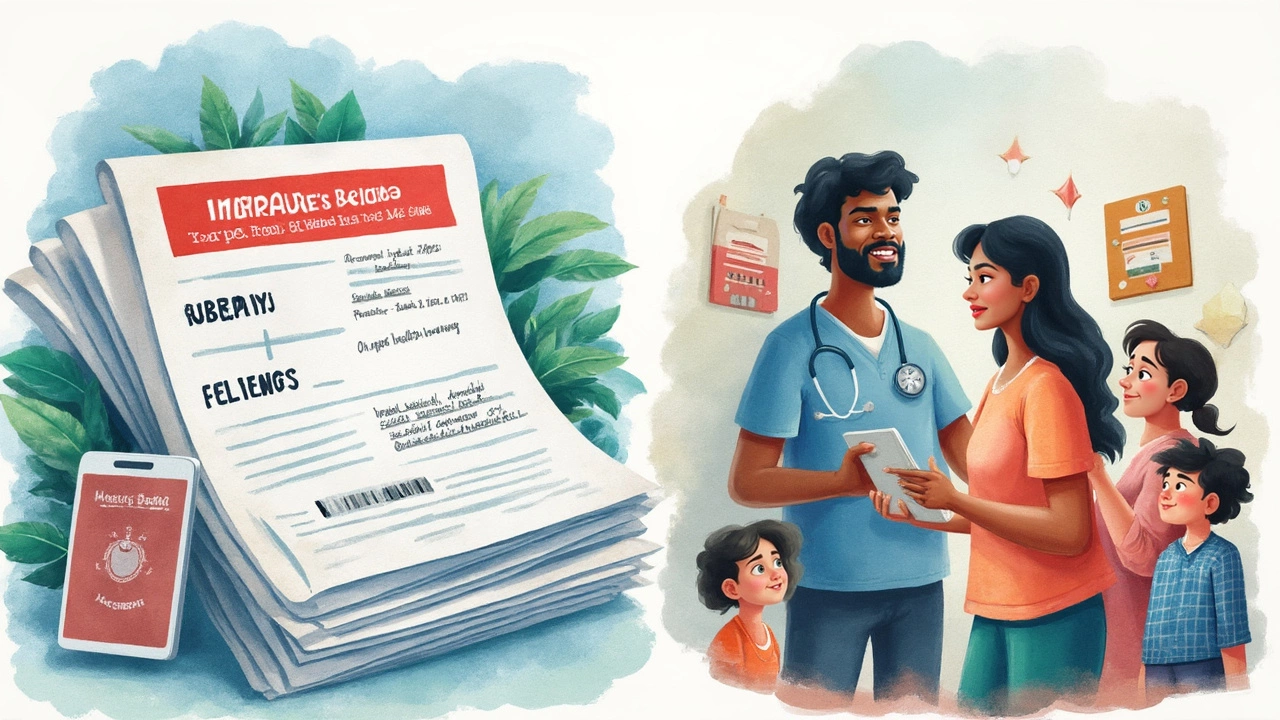Ever felt like insurance rules are written in another language? If you’re thinking about getting Ozempic online, the first big question is whether your insurance will even pay for it. Here’s the deal: insurance companies don't just hand out coverage for Ozempic automatically, even though it’s a game-changer for many people with type 2 diabetes. They’ve got their checklists, red tape, and fine print.
Some plans will nod along if your doctor prescribes Ozempic for diabetes, but slam on the brakes if you want it for weight loss—even though that’s how loads of people are using it in real life. Insurers keep changing their rules, especially as more folks ask for these new expensive meds. So, before you hit the “checkout” button on an online pharmacy, you need to know what makes them say yes or no.
- How Insurance Decides on Ozempic
- Why Coverage Gets Denied
- Navigating Online Pharmacies
- Tips for Getting Approved
- Alternatives If You’re Denied
How Insurance Decides on Ozempic
Insurance companies love making things complicated, especially when it comes to new, high-demand meds like Ozempic. Whether your plan covers it or not depends on a mix of factors—and it’s not just your doctor’s say-so.
First, they look at the official FDA approval—Ozempic is approved for type 2 diabetes, not just weight loss. So if your prescription says “for diabetes,” your odds go up. If it’s for “weight management,” expect more resistance. Some insurers deny coverage outright unless you’ve already tried—and failed—cheaper diabetes drugs.
Many plans use a system called a drug formulary, which is just a fancy word for a list of meds they’ll pay for. Ozempic usually sits in a higher “tier,” meaning you’ll likely face bigger copays or need extra paperwork.
- Prior Authorization: Most insurers want to see more info from your doctor before approving Ozempic. That means more forms and a wait to see if you qualify.
- Step Therapy: Some companies require you to try less expensive drugs first. No luck? Only then do they consider covering Ozempic.
- Quantity Limits: Even when approved, insurance might cap how much you get per month to keep costs down.
Want some hard numbers? Around 60% of commercial insurance plans in the U.S. list Ozempic as "non-preferred" or "restricted" on their formularies, according to a 2024 Pharmacy Benefit Report. That's a big reason people get frustrated at the pharmacy counter.
Before you try filling your script online, always check what your specific plan says. The details can be buried in your insurer’s drug list, and even two people with the same plan might not get the same answer.
Why Coverage Gets Denied
Getting Ozempic through your insurance isn’t a sure bet, and denials are pretty common these days. The main reason? Insurance companies only want to pay if you tick the right boxes—and their boxes are pretty specific. If your doctor wrote up Ozempic for managing type 2 diabetes, you’re much more likely to hear “yes.” But if you’re hoping to use it for weight loss, most plans just say no, since the FDA hasn’t approved Ozempic for that reason yet.
Papers matter too. Many insurance plans demand “prior authorization.” That means your doctor has to prove why you need Ozempic before they’ll pay. If that paperwork is missing or doesn’t fit their rules, expect a quick denial. And if you’re getting your prescription from an online pharmacy, some insurance companies also get picky about where you’re filling it.
- Diagnosis mismatch: If your records don’t show type 2 diabetes, coverage almost always gets denied.
- Step therapy rules: Some plans make you try cheaper drugs first—if you skip these, denial is super likely.
- Missing documents: If your doctor forgets to send lab results or notes, insurance will hit pause on your claim.
- Refill frequency: Requesting refills too soon? Many policies have strict refill dating and won’t budge.
Here’s a quick look at why insurance might deny Ozempic:
| Reason for Denial | Chance of Denial (Est.) |
|---|---|
| No diabetes diagnosis | Very high |
| Not meeting step therapy | High |
| Using for weight loss only | Extremely high |
| Prior authorization missing | High |
If you get denied, don’t panic. Appeal decisions are possible, and sometimes it’s just a missed document or a box that wasn’t checked. Always talk with your doctor and double-check your plan’s requirements before buying Ozempic, especially from an online pharmacy—it can save you a major headache later.

Navigating Online Pharmacies
Buying Ozempic from an online pharmacy isn't as simple as dropping it in your cart and paying with a credit card. Here’s what you need to watch for if you want insurance to help with the bill.
First off, legit pharmacies—think names like Walgreens, CVS, or even places like Amazon Pharmacy—will ask for a valid prescription up front. If a website says you can buy Ozempic without one, that's a massive red flag. Stick with online pharmacies that are licensed in the U.S. and offer pharmacist support. You can check a pharmacy’s license using the NABP “.pharmacy” site or your state's pharmacy board.
Insurance may not always play nicely with online orders. Some insurers only cover pharmacy networks they contract with. That means your favorite online pharmacy might not count—even if it’s cheaper or more convenient. It’s smart to:
- Call your insurance, ask if the online pharmacy is "in network."
- Check if your insurance coverage requires you to use a specific mail-order pharmacy. Some Medicaid and Medicare plans do.
- Confirm your plan’s process for submitting receipts or claims if paying out of pocket online.
Here’s a quick snapshot of what you might run into buying Ozempic online:
| Pharmacy Type | Prescription Required? | Insurance Accepted? |
|---|---|---|
| Major Chain (CVS, Walgreens, Amazon) | Yes | Often |
| Independent/Regional | Yes | Sometimes |
| Unregulated/Non-U.S. Site | No/"Online consult" only | No |
If you do end up paying full price, ask about manufacturer savings cards. Ozempic’s parent company, Novo Nordisk, sometimes gives discounts. Don’t be afraid to shop around or even ask your doctor if they know tricks for approved pharmacies.
Bottom line: double-check everything before you order. It could mean the difference between insurance picking up the tab or you getting stuck with a sky-high bill for your prescription medication.
Tips for Getting Approved
If you want to boost your chances of your insurance covering Ozempic, it’s all about knowing what triggers a "yes". Don’t just fill the prescription and hope for the best—there are steps that move things along.
First, your doctor is your MVP. Make sure your medical records show exactly why you need Ozempic. Insurance companies want proof—diagnosis of type 2 diabetes, your past A1C results, and whether you’ve tried other meds. If you haven’t tried cheaper, older drugs like metformin first, approval is going to be a long shot.
Most insurance plans want a “prior authorization.” It’s paperwork your doctor has to send, explaining why Ozempic is necessary for you specifically. If your doctor knows their way around this form, you’re halfway there. Ask if they’ve done prior authorizations for Ozempic before—they’ll know what to write.
Here’s a quick checklist to help get that "yes":
- Have a clear diagnosis of type 2 diabetes in your chart.
- Get lab results on file (like A1C levels above 7%).
- List any meds you’ve already tried and failed (metformin, glipizide, etc).
- Ask your doctor to highlight if you have health risks: heart disease, obesity, kidney issues—these sway insurance companies.
- Double-check your pharmacy benefits: make sure Ozempic is even listed, or if a different pharmacy is required for specialty meds.
Packed prior authorizations move faster—some clinics say approvals go up 40% when forms are filled out completely the first time. If you get denied, don’t panic. Most denials just mean the insurer wants more documentation or a longer medication history, not a hard no.
And don’t forget: drug makers like Novo Nordisk offer savings cards for folks with commercial insurance. A savings card can drop your copay for Ozempic to as low as $25 a month if you qualify. Always check the manufacturer’s website before you pay.
| Step | Why It Matters |
|---|---|
| Proof of Diagnosis | Insurance wants clear medical records for type 2 diabetes. |
| Document Failed Meds | Shows you tried cheaper treatments first. |
| Complete Prior Auth | Less missing info means fewer delays. |
| Use Copay Cards | Lowers your out-of-pocket if approved. |
Insurance hoops can be a hassle, but a little prep goes a long way before you order Ozempic through an online pharmacy.

Alternatives If You’re Denied
If your insurance shuts the door on Ozempic, it’s definitely not game over. You’ve got a few smart moves and backup options—even if the system makes things tough. Here’s how people are handling things right now:
- Manufacturer Savings Programs: Novo Nordisk, the company behind Ozempic, sometimes offers savings cards or coupons, especially if you have commercial insurance (not government plans). These can trim a chunk off your out-of-pocket costs, sometimes by hundreds a month. You’ll need to register on their website and see if you qualify.
- Switch to a Similar Medication: Drugs like Wegovy (also semaglutide but for weight management), Trulicity, Rybelsus (oral version of semaglutide), or Victoza work in similar ways. Some of these have better coverage, depending on your insurance. You might need to ask your doctor if a switch makes sense for your situation.
- Generic Alternatives: There isn’t a generic version of Ozempic yet in the US (as of April 2025), but there are other, much older drugs for type 2 diabetes with generic options. Metformin is the classic go-to, usually super cheap, but it doesn’t help with weight loss like Ozempic does.
- Appeal or Ask for a Prior Authorization: Some insurance companies want to see extra paperwork, like proof you’ve tried other meds first. Your doctor can help fight this—ask about an appeal or a special authorization request if you really need Ozempic.
- Online Pharmacy Discounts: Some legit online pharmacies offer price breaks or connect you with telehealth doctors who know the insurance hoops. Double-check that any website is licensed and not a shady overseas outfit.
Here’s a quick look at average cash prices (without insurance) for Ozempic and some similar meds, so you know what you’re dealing with:
| Medication | Average Monthly Cost (USD) |
|---|---|
| Ozempic | $950–$1,100 |
| Wegovy | $1,350 |
| Trulicity | $900–$1,000 |
| Rybelsus | $850–$950 |
| Metformin (Generic) | $10–$20 |
Bottom line? If your insurance coverage falls through, don’t give up right away. There’s almost always another route, whether it’s asking your doc about other meds or searching for discounts. And if you go the online pharmacy route, look for real credentials to avoid scams. Every move counts with these pricey meds!
